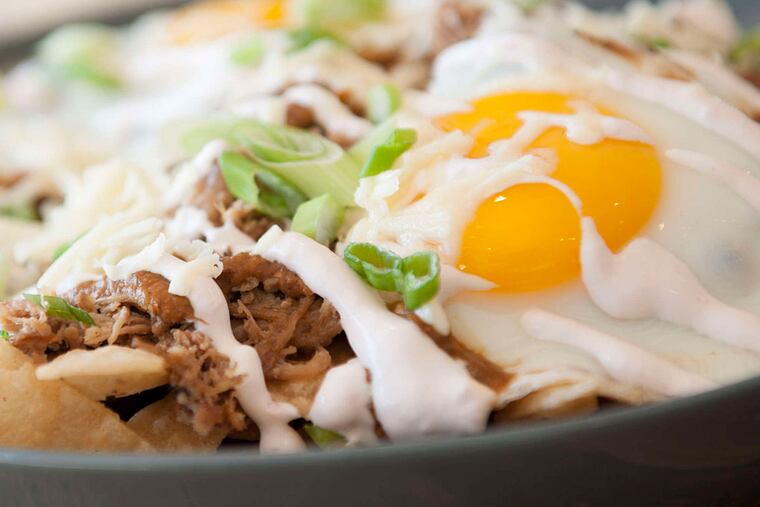American the beautiful: Trusting processed cheese
Once, there was a time in your life when a slice of cheese was orange and smooth, when it was wrapped in cellophane, when it was called a "single."

Once, there was a time in your life when a slice of cheese was orange and smooth, when it was wrapped in cellophane, when it was called a "single."
Sure, nowadays you choose to nibble on aged Gouda for a snack; you have your favorite blues and goats; and you'll order anything on a restaurant menu with tallegio.
But a part of you - hidden in the most unacknowledged recesses of your palate - still secretly craves the uniform texture and yielding blandness of American cheese.
To that, some local chefs would say: No shame in your game.
"Look, I don't know if chefs will tell you if they're eating American behind closed doors," says Kriss Serviss of Blue Duck in the Northeast, "but it's good enough for me."
Serviss uses the processed foodstuff during brunch and dinner hours. It makes an unconventional appearance on the house huevos rancheros over duck confit and a strawberry avocado crema, and also on the pork roll burger with the added embellishments of fried egg and sriracha mayo.
Serviss has even been known to stick a block of Cooper American (his American of choice) on the grill until it browns up and crisps around the edges and gets soft and gooey on the inside - a sort of proletariat fondue. That's not to mention staff meals, where it's melted down to become the saucy base for macaroni.
At a time when the local cheesemaking industry is booming and Pennsylvania and New Jersey farm cheeses are making their way onto platters alongside the Humboldt Fogs and Bayley Hazen Blues of the world, some chefs are still clinging to American (or perhaps it's just clinging to their sandwiches, because it's sticky like that).
"Given the enormous interest in small-batch artisanal cheeses," says cheese expert Tenaya Darlington, a.k.a. Madame Fromage, "it's interesting to see chefs bucking the trend."
And you'll see it if you look anyplace where comfort, down-home, guilty- pleasure-wallowing food is served. Its unmistakable sheen is on Federal Donuts' recently introduced fried-chicken sandwich, many of the biscuit concoctions at Scratch, and uncountable bar burgers around town.
Love it or hate it, no one will argue with its adhesive and unctuous properties that make it such a standout in the dairy case. A grilled cheese can successfully accommodate many varieties, but the orange stuff, whether alone or in combination with others, is undeniably classic.
Momofuku pastry chef Christina Tosi (a fan of all foods junky and nostalgic) shares a favorite grilled-cheese recipe in her Milk Bar at Home (Clarkson Potter, 2015), which benefits from the addition of Kewpie mayonnaise, a popular Japanese spread, on the outside of the bread, in addition to the American.
Maybe it's not exactly cool again, but American has its fans. In Dale Talde's new cookbook, Asian-American (Grand Central Life & Style, 2015), the Brooklyn celebrity chef serves up a remix recipe whereby the food truck/deli standard of egg, cheese, and sausage on a roll becomes a fried rice dish, the yellow cheese liquefying amiably around the rice and crumbles of chorizo.
That's not even mentioning cheesesteaks, where it's already considered a sacred binder of sirloin, an important salty counterpoint to the sweet fried onion. (And if you think Whiz is that far off from American, you're sadly mistaken.)
At the Ritz-Carlton's 10 Arts, chef Matthew Hitch uses American in his bar cheesesteak, and it's also the foundation for a dipping sauce for soft pretzels.
"I'm personally not too into it, but it has its place - it emulsifies really easily, unlike regular cheddar. That consistency is really nice in a sauce, and it has a nice mouthfeel and neutral quality," Hitch says, "which makes it go with lots of different flavors."
Technically, of course, American cheese is not considered "cheese" at all, but a "cheese product," a term that strikes fear in the hearts of all whole-foods eaters. Add to this the YouTube video controversy going around last year when people attempted (unsuccessfully) to melt Kraft cheese on an open flame. Kraft responded with its own video showing how the cheese melts best indirectly (between slices of bread, for example).
"It surprises me that people would want something that's so full of preservatives in a time when we're moving away from fillers and oils in our food," says Darlington. "It does have good meltability, but I would rather have blue cheese on my burger. To me, there are many local cheeses that embody the true American spirit, as opposed to something dyed and unexciting, but there's a time and place for all cheese."
Yet, despite (or perhaps because of) its chemical curiosities, American cheese has a nostalgic hold. For all the diners who order the cheesesteak at 10 Arts, only a rare few seem to ask for a substitution of provolone. "I think people tend to go with it because they remember eating American when they were growing up," Hitch says. "It's just something that's probably going to be with us forever."